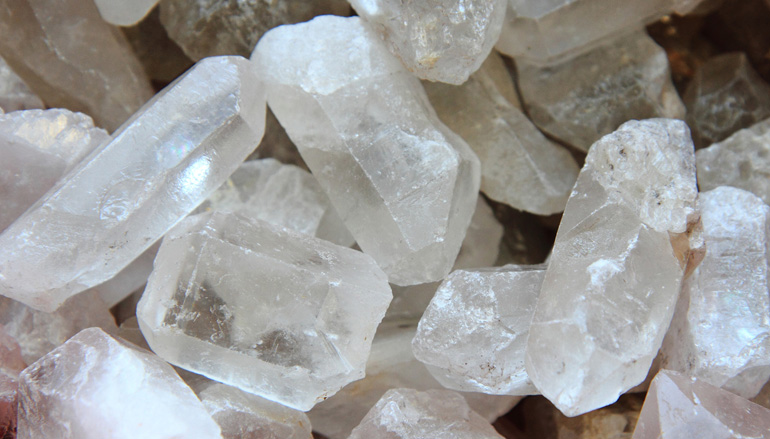Quartz is a silicon dioxide mineral that is as omnipresent in commercial use as aluminum, steel, glass, or plastic. This isn’t too surprising considering that quartz is the second most commonly occurring mineral in our planet’s continental crust. Although it’s pretty easy to harvest—with some geographical locations like Arkansas and Brazil noted for their abundance—its vital use in modern technology requires quartz to be more available than the time it takes to dig it up. In relation to this reality, naturally occurring quartz isn’t as pure as crystals that can be synthesized in industrial manufacturing facilities. So when you see “quartz” on a battery-operated-watch dial, it’s very likely that the crystal inside (or covering the dial) was not a naturally occurring one. This is because the synthesis of commercial quartz—used in watches and otherwise—has lead to much purer and more energy efficient crystals. These crystals can be made in large batches using techniques that work faster than the Earth’s natural processes. They may not be as organic as the kale you get at Whole Foods, but the qualities of synthesized quartz crystals are why electronics employ their electric frequencies in daily use.

Within watches, quartz crystals (synthesized and otherwise) are put under pressure via battery power. This pressure causes them to put out an electric frequency of their own. Placing pressure on quartz crystals—or any other substance—to release an electric frequency is referred to as piezoelectricity. This frequency acts at regular intervals, so quartz crystals are great for regular and precise ticking on a watch. Because of this reliability, as well, quartz crystals are utilized in modern computing. When linked up to circuit boards, these tiny mineral crystals help regulate the flow of electric current while processing electronically coded information. Modern synthetic quartz—outside of watches—can be found in smartwatches, drones, AC units, televisions, digital cameras, and plethora more devices. Regular pressure on these crystals makes any on-board CPU built into an electronic device sing smoothly and consistently as it operates.
Besides their internal electric use, quartz mineral crystals are also used as protective glass—in industrial use. On watches, quartz crystals are the most commonly used material for watch “crystals”. We quote “crystals” in this case for some clarity: The part of the watch that covers the dial is, confusingly enough, also referred to as a “crystal” in horology—regardless of the material. Besides synthetic quartz being used for watch crystals, its other uses are similarly plentiful. Due to its toughness and clear visibility transmission, quartz and quartz-like silicate glass is used as a see-through protective shield on car windshields, home windows, and various optical lenses. When synthetic quartz is manufactured for watches and these other uses, it typically comes out at 99.9999% purity. This purity is why synthetic quartz is more reliable for visibility and protective use. It makes the material harder and more crystal clear than naturally occurring quartz. Unfortunately, the naturally occurring crystals feature flaws like tiny cracks and fissures—which makes these Earth-grown minerals more opaque—and much more susceptible to further damage.

Often referred to as the “salt” of industry, several hundred thousand electronic components can be made from a single synthesized quartz crystal. Japan is the current leader in manufacturing and distribution of synthetic quartz crystals, in modern manufacturing. However, the need for naturally occurring quartz makes Brazil and the U.S. State of Arkansas the highest producers of naturally occurring quartz on the market. Coming in at a whopping 8 kilograms or more, many industrially synthesized quartz crystals require a fair amount of natural silica dioxide. By superheating the dug up quartz, alongside sheets of pre-synthesized material, manufacturers grow massive batches of large synthetic quartz crystals. This process can take up to 6 months to complete—so continued processing of these materials is vital in keeping up with modern demand for quartz-utilizing tech. On a related side-note: Different forms of quartz are naturally found and synthesized for more aesthetic reasons, often to the delight of many jewelry enthusiasts, but have no practical application in watchmaking or electronics.
For fun, anyone can try to synthesize quartz crystals at home. All you need is a little bit of the natural ingredients—a naturally occurring quartz crystal will do—and a pressure cooker. But be sure to do it just right, however, or you can end up with nothing but a gel. Quartz fascination can be enjoyed regardless of at-home synthesis, as well. With plenty of deposits to be found all over the world, it’s easy to become a rock hound and search out natural quartz crystals in your own backyard. Beyond rockhounding, it’s easy to find synthetic relatives to this mineral material all over (and within) any commercial products you have in your home. At the very least, quartz is on your wrist any time you’re keeping quartz analog (or digital) time. All you have to do is keep an eye on your dial—as it ticks in regular intervals—to participate in the quartz club. As it stands, the rest of the modern world is right there with you.

